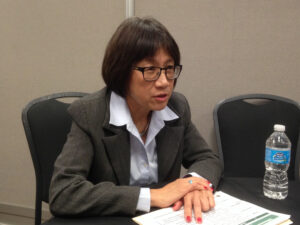Shyu Mum On More Acquisition Powers For Odierno
Posted on

Gen. Ray Odierno
HUNTSVILLE, ALA: There seems to be little support for Army Chief of Staff Ray Odierno‘s push for the four service chiefs to get greater authority over procurement — not even from the Army’s civilian head of acquisition Heidi Shyu.

Heidi Shyu
It’s not actually clear exactly what Odierno wants. “We’re still working through the exact authorities” in response to a congressional request for more detail, Odierno said when I raised the issue during a roundtable at the Association of the US Army conference here.
What’s necessary, he said, is for the service chiefs to have a formal role in acquisition at all stages. Currently, the chiefs control requirements, which define what a program must deliver — the speed of an aircraft, the firepower of a tank, the bandwidth of a battle network — but all the research, development, procurement, and contracting to fulfill those requirements is controlled by civilian officials.
“I’m not trying to have the chief replace the [civilian] acquisition executive, that’s still obviously very critical and we have to that,” Odierno said, “[but] I’d like to see us have a broader input, because of the expertise and experience we [service chiefs] would bring.”
But the top Army civilian on acquisition carefully sidestepped the subject when I pressed her about Odierno’s request for additional authorities. I asked Shyu at her AUSA roundtable what she thought the appropriate role was for an Army chief of staff. “The biggest impact that the chief personally can make in acquisition is up front,” she said. “[He can] set the proper requirements, but based upon what’s the art of the possible informed by technical risks, informed by cost, informed by schedule.”
That’s a reform that can “absolutely” be done without needing new laws, Shyu said. “They own the requirements today, but where we can do a better job is literally get the chief to be reviewing… personally…. all of our major programs, our major platforms. It would be great if we could get the service chief involved up front to review all the requirements, [to say] ‘yeah, this is what i want in the future.'”
So Shyu would like to see the chief of staff make greater use of his existing authorities over requirements. Despite my pressing, she stayed significantly silent on the idea of giving him additional authorities.
“The service chiefs talk about how they want more acquisition authority,” a House Armed Services Committee staffer told reporters last week. “While it’s certainly a good discussion to have, at this point we’re not really sure what is the problem that…they think needs to get fixed… So what we do is we basically direct them to tell us, what’s wrong, why do you think this is a problem, [and] what would you change?”
The new HASC chairman, Rep. Mac Thornberry, last week rolled out “increment one” of his multi-year campaign to reform acquisition. This first step emphasizes picking low-hanging fruit and clearing brush by removing redundant bureaucracy. One thing the Thornberry plan does not include, so far, is additional authority for the uniformed chiefs of the four armed services, something Odierno in particular has asked for
As a service chief under the current system, “you influence the acquisition process, priorities, funding, decisions…by your personality,” Odierno said. “You have no authority. I’d like to see us get authority in those areas, where we are part of the approval authority [for] these programs.”
That argument won’t go far on Capitol Hill. “I don’t see how it improves the process,” one former congressional staffer told me. “I understand his frustration but it sounds like the bureaucracy is just going to get bigger and approval will take longer.”
“The service chiefs have plenty of authority already, through the budget process,” a current Hill staffer said. “Most just choose not to use it fully.” Some do. Former chief of staff Eric Shinseki, for example, was able to push through the Stryker vehicle program — now an Army mainstay — and the Future Combat Systems — a disaster — without asking for additional legislation.
FCS was born of Shinseki’s ambition for an air-deployable force of high-tech, light-weight armored vehicles and robots, a total of 18 separate systems plus an overarching wireless network. “There was so much put into one program, and the chief dictated accelerating the program,” Shyu said at AUSA. “Well, you know, dictating technology, you may command this [invention] to appear, it just” — and here the experienced engineer laughed out loud — “it just doesn’t work that way.”
So active involvement by the service chief isn’t always helpful, and their extensive military experience doesn’t always translate well to program management. “A lot of people don’t know how the present system evolved in the 1970s and early 1980s,” the Hill staffer said. “Overall, the goal was to ‘professionalize’ and ‘civilianize’ the acquisition system. That was in reaction to a series of disasters blamed, in part, on idiosyncratic and capricious decisions by — wait for it — service chiefs.”
By contrast, Shyu was full of enthusiasm for Thornberry’s approach. “He actually proactively talked to the defense acquisition executive [Frank Kendall] and individually talked to each of the service acquisition executives,” she said. “I can tell you, each of the services have been working closely with OSD to identify, ‘here’s the stuff that’s really onerous, here’s the low hanging fruit.'”
To start with, “just alleviate some of the onerous documentation,” Shyu said. She and her staff have counted “79 different documents” that a program manager must submit to reach a formal milestone. Some of these are simply wastes of paper and time.
“One example is a manpower estimate,” she said. “In the beginning of a program, you have to have exquisite knowledge exactly who you need on the program for the duration of the life of the program; and then when the program changes” — which it inevitably does — “you’ve got to continuously update that.”
The Pentagon is also reviewing bureaucratic restrictions it imposes on itself, things it could fix using its existing authorities without waiting for new legislation. Thornberry’s favorite example here is corrosion studies, originally instituted for naval vessels, which the military has made mandatory for all programs — even software development projects where there’s no physical product to corrode.
“It’s nuts,” Shyu said. “One of the things we’ve done internally is look at all the documentation that’s not in DoD 5000 [the main defense acquisition regulation] to eliminate the dumb things we’re doing to ourselves.”
On these broader principles of reform, Shyu and Odierno were in perfect alignment. “We have to make it easier and reduce some of the bureaucracy involved,” the general said. “The world we live in today is one that moves much faster, information moves faster. We have to be able to move faster with it, and I think our current acquisition bureaucracy slows us down too much.”
With both Thornberry and his Senate Armed Services counterpart, John McCain, both championing acquisition reform, “I think we have a unique opportunity to do it,” Odierno said. “I also think it’s essential because of where we are and the budget pressures that we’re under.”
Subscribe to our newsletter
Promotions, new products and sales. Directly to your inbox.
